Rolling Green Golf Club
by Wayne Morrison
In October 1920, a group of members of Springhaven Country Club, encouraged by Joseph E. Haines (Uncle Joe), considered the task of forming a golf club for golfers. This was not an entirely new concept along Philadelphia’s Main Line. Merion Golf Club was spun off the membership of the Merion Cricket Club becoming a separate enclave for golfers. Merion became the first club in America with 36 holes after the West Course was completed in 1914 to complement the championship East Course. The Certificate of Incorporation for Rolling Green Golf Club was approved and entered into the county records in November 1924. William Stephen Flynn was chosen in May 1925 as the course architect and construction commenced in the same month.
Rolling Green opened for play in 1926, a local paper wrote: ‘The original purpose of the club’s founders was to omit all social frills that enter into the life of a country club, and make it a shrine where the skill and ingenuity of the lover of the game could have full play.’ In fact, the Quaker dominated membership wanted to avoid the social drinking found at their original club and it wasn’t until 1970 that Rolling Green Golf Club had a liquor license. That isn’t to say however that some of the members’ lockers didn’t contain a fifth of their favorite beverage. The demand for such a club was evidenced by the fact that the membership was closed before the club or the clubhouse was completed. The 335th and final certificate was sold on August 9, 1926 for $1,050 in comparison to the face value of $600.
The 157 acres that comprise the land that the golf course is situated on is ideal for a parkland golf course. There are rolling hills and quite a lot of elevation changes on individual holes and throughout the course. Streams meander throughout the course, but mostly along the periphery of the holes serving to frame the holes. There are a number of hardwood trees such as oak, sycamore, maple, and ash throughout the course. There is a total of 130 feet of elevation change from the highest point near the 5th green to the lowest point where the creek exits the property on the 8th fairway. The typical course conditions are kept firm and fast through the green. The greens themselves protect par under normal circumstances by playing so that the ball lightly dents. It is hard to dial in approaches due to the maintenance meld and you really have to think about how the ball will react to the aerial game. The ground contours are complex on the approaches to the green. Except for some of the steeply uphill holes (4, 8, 11, 12, and 15) you can play the game along the ground, but local knowledge is very helpful.
The only national tournament held at Rolling Green was the US Women’s Open in 1976. This bicentennial event was played at just over 6000 yards, the shortest Open in the modern era. Yet the course provided a stern test for the lady golfers. Sandra Palmer and JoAnne Carner, the previous year’s winner and runner-up, tied at plus eight. Carner shot a 76 but won the playoff the following day as Palmer shot a 78. The club has hosted many local tournaments, such as the Philadelphia Women’s Amateur, where such greats as Glenna Collett Vare, Dorothy Germain Porter, and Helen Sigel Wilson have participated. To this day, par has never been broken in any competition of 36 holes or more.
Hole 1: 388 yards, par 4
The fairway cants a bit from left to right bringing the fairway bunker into play. The real test is the second shot. With a green that slopes severely from back to front, being above the hole is a mistake. The green is large, and there is a significant break in putts from right to left. Deep bunkers guard the left side of the green; a tricky downhill chip awaits those that miss the green right.

A benign tee shot is followed by a demanding second shot to a large green where placement is key. Any lofted shot that lands into the crown fronting the green will not advance very far onto the green.
Hole 2: 441 yards, par 4
The tee shot sets up play particularly so on this dogleg left hole. The fairway will push any shots landing in the middle or middle-right of the fairway into the right hand rough. Perhaps the fairway should be widened on this side, as that is the best approach. A good drive that carries the bunkers left at the top of the hill will give the drive a turbo boost leaving a shorter iron approach to a green that is difficult to hold. The green slopes left to right and back to front. The right greenside bunker is particularly below green level.
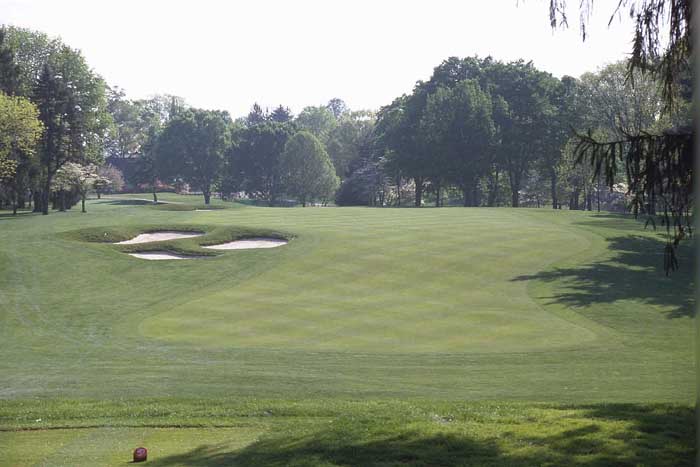
The tee shot over a depression and onto a left to right sloping fairway.
Hole 3: 162 yards, par 3
Although it looks as though the green tilts severely back to front, it is an illusion due to the downhill topography. Putts back to front are much slower than one thinks and the putts from front to back seem much quicker than one would ever imagine. All shots run from right front to back left. Saving par from any of the three greenside bunkers is an achievement.
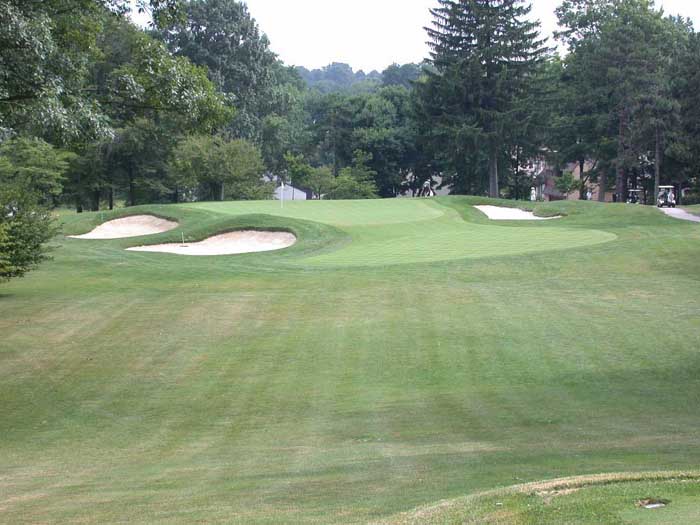
The false front really adds to the misperception that the green slopes severely from back to front.
Hole 4: 375 yards, par 4
We get our first look at the 11 holes that have significant uphill approaches. Best to aim the tee shot down the right hand side of the fairway. Having noticed the pin placement from the 2nd tee, it is possible to know how to hit the second shot approach to a deceptive, elevated green. The approach requires at least one club more than you think; shots played short or those with excess spin will roll down the hill and leave a testy approach.
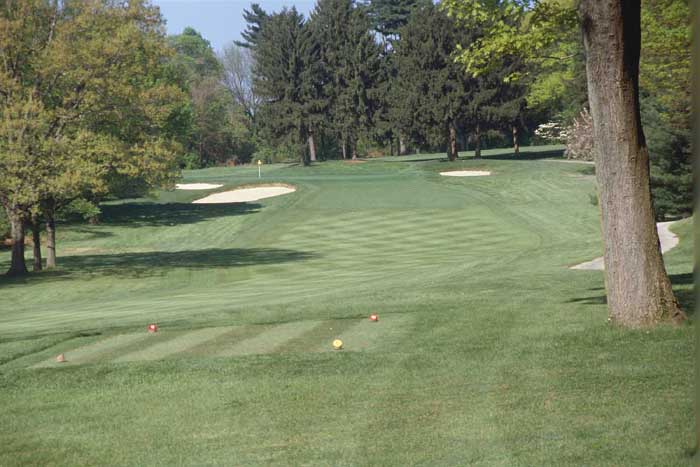
This is an example of a typical Flynn uphill par 4. The camera doesn't show how uphill this shot truly is. Flynn often designed multiple green side bunkers on one side dug into the slope and utilized a single bunker on the opposite side that is flashed up to green level.
Hole 5: 410 yards, par 4
A new back tee, about 40 yards behind and 10 yards left of the original tee results in an uphill blind tee shot. Aim for the gap in the tree line on the left and get a turbo boost if you hit it far enough to reach the back slope of a large contour in the fairway. There are wonderful rolls down much of the landing area. One can get lucky with a turbo boost, but an anti-turbo boost is also possible if you hit into one of the rolls. With a right front pin, you must land the shot short of the left side of the green so that the ball will not run and trickle down the severe left to right slope. Two deep bunkers on the right guard the green while shots out of the left bunker must contend with a subtle but effective slope away from the player. This is the highest elevation on the course.
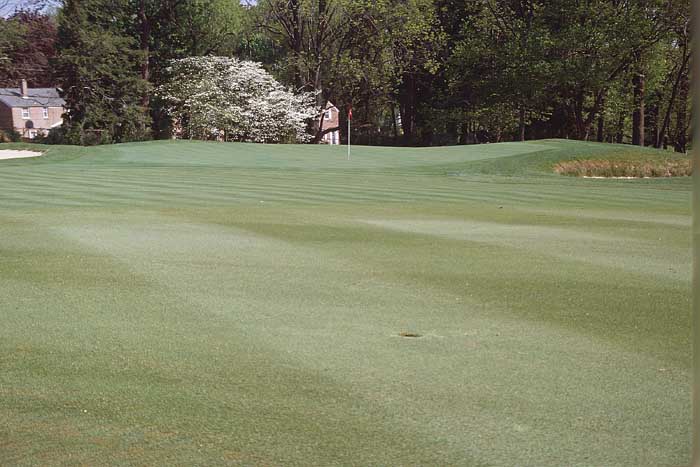
There are many difficult pin positions on this highly contoured green. To get near this pin position, the ideal shot must land short and on the far left side of the green.
Hole 6: 185 yards, par 3
This is an uphill par 3 with two bunkers right carved into the hillside and one bunker left closer to green level.

There is no relief for the pulled or the pushed shot. Best to hit the straight ball here.
Hole 7: 500 yards, par 5
This short par 5 is definitely a birdie hole. A player needs such a hole as a daunting stretch of holes await. It starts with a dramatic tee shot from an elevated tee. The foot bridge, or just to the left of it, in the distance is the target. The tee shot need not be long, just straight. To the left are woods, a creek, and finally a boundary fence. To the right are woods and a hardpan that can carry a long drive into the creek. It is approximately 330 yards from the tee to the creek in the center of the fairway. The second fairway slopes from right to left so that all shots short of the green must be played to the right side of the fairway. A long iron to this green will run on nicely if played on the right side. Even shorter third shots to the green must be played to the right front side (a small umbrella shaped tree behind the green is a good mark to aim for) for a kick towards the center of the green.
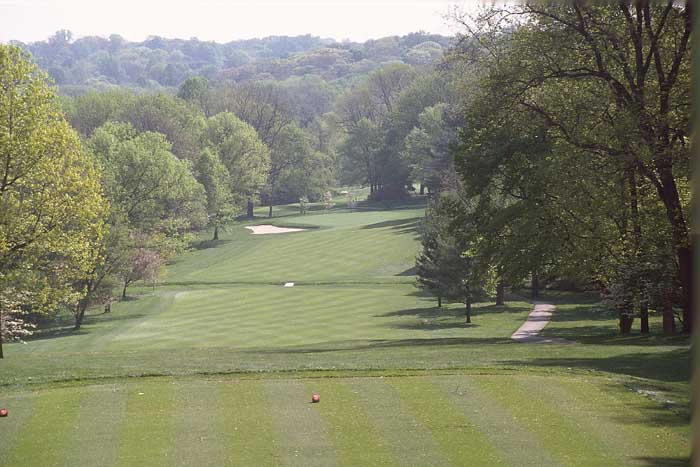
A beautiful tee shot, especially on fall days with the foliage in an array of colors.
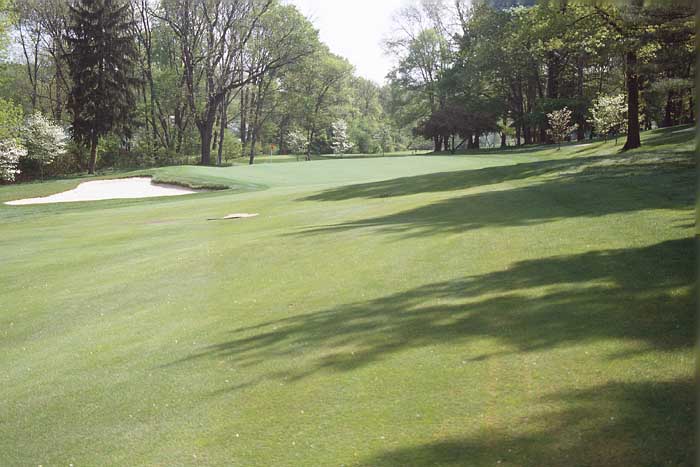
Beautiful green site with the fairway sloped right to left all the way to the green.

Looking back from behind the green. The line of evergreen trees along the cart path ought to be removed and the cart path moved up the hill.
Hole 8: 425 yards, par 4
This is one of Rolling Green’s toughest par 4 and the beginning of a tough stretch of holes. A par here can seem like a birdie. Only a long drive can carry the middle of the fairway from the member’s tees. The more you draw the ball, the more you have to carry the ball to the second fairway due to the arc of a creek that crosses the fairway. From the back tees, you must hit to the island first fairway (there are three branches to the creek that surrounds the first fairway) and have a 200-yard steeply uphill approach shot. The front pin position on this two-tiered green is most difficult. Trying to get cute and keep the ball below the pin on this very severe back to front sloping green often leads to a shot that rolls 60 yards down the hill. In a better ball of partners match here, one member picked up as he lay 4 in the fairway and his partner lay 2 on the green. The partner whose ball remained in play putted off the green and after several shots that fell short or spun off the green and rolled down the hill walked away with a 12!

You can see how the creek arcs from near right to far left (the lowest section of the course). The back tee is about 30 yards behind this camera position.
Hole 9: 614 yards, par 5
One of the longest holes in the district and it plays longer than its yardage as it plays nearly the entire length uphill. The landing area of the tee shot slopes severely left to right and you must start the tee shot along the left hand side of the fairway so that it does not roll into a large collection bunker. The second shot is best played toward the right side of the fairway so as not to bring into play the green side bunkers on the subsequent shot. The fairway has rolling contours and a sideways slope all the way to the first fairway bunker on the left. After this it levels off a bit but the third shot to the green from this point is still uphill and you must play at least one more club than normal. Approach shots that land beyond the pin will result in a fast breaking putt back to the hole. Only two or three people have ever reached this green in two from the members’ tee (561 yards) in the 76 years of play. I doubt that anyone could reach the green in two from the back tee, especially given the side hill lie that one is sure to have for the second shot.

It is a long way home from this back tee. Unfortunately, this shot does not adequately show the severe cant of the fairway and the uphill nature of the hole. A 30-yard long collection bunker is just out of view beyond the slight fairway extension on the right side.
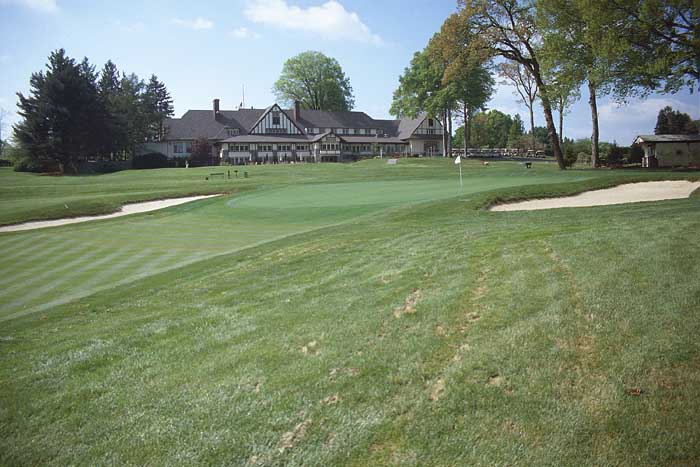
Approach shots that hit into the slight crown fronting the green will not advance towards the hole. The stately clubhouse looks over the 9th green and the 10th tee.
Hole 10 – 243 yards, par 3
Originally drawn as a 260-yard hole, we hope to put in a back tee that will reflect William Flynn’s plan. This slightly uphill shot is quite demanding. Four bunkers guard the left side of the hole from about 60 yards short of the hole to the front portion of the green. From the middle of the members’ tee the hole plays 214 yards and requires a long iron aimed at the right bunker. The landing area short of the bunker will kick the ball left and onto the green. From the championship tee, most players need all the distance they can manage. The green is sloped back to front and right to left. There is a dramatic fall off at the rear of the green.
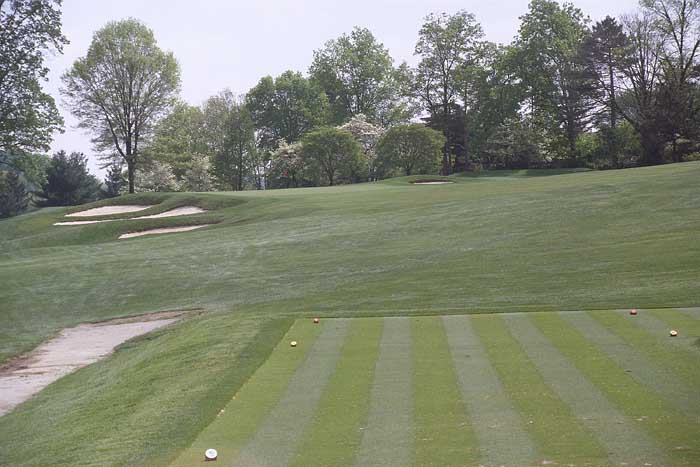
Not all of the left side bunkers are visible from the tee. The right hand bunker is where to aim your long iron run up shot.
Hole 11: 426 yards, par 4
One of the nicest tee shots on the course. From an elevated tee, the hole is perfectly visible and there are no secrets as to how to play this hole. One must avoid the deep right hand rough (some of the most difficult on the course) and the left fairway bunker that is in the landing area from the members’ tee and a ball from the championship tee can run into this trap. The large tree beyond and left of the left greenside bunker is no longer there. The green is sloped back to front and left to right. From the right side of the fairway one should aim for the left bank of the green. A well-struck tee shot from the members’ tee over the fairway trap will get a turbo boost and leave a short iron into the green. Only a front left pin placement is difficult from here. Shots missed right of the right greenside bunker is very difficult to recover from. You may not be able to see the flag and you certainly do not want to be in the deep bunker that is fronting the green from such an angle. The approach to this green is similar to the par 5 3rd at Philadelphia Country Club. A shot missed right on this hole results in a shot that is similar to the 17th at Philadelphia Country Club. Not too surprising since Philadelphia Country Club was completed a year after Rolling Green.
The modern-style mowing pattern shown here persists throughout the course. Many holes would benefit from having a less-clear indication of the ground contours, leaving the golfer to make the decision on how best to approach the green.

What a wonderful view from this tee! OB is right of the tree line that covers the length of the hole.
Hole 12: 343 yards, par 4
This is one of the very great short par 4 holes in golf. From the back tee, a long iron left of center will set up the approach shot to a very small and wonderfully bunkered green. Landing the approach shot into one of the 5 surrounding bunkers is preferable to going long, especially long right down a steep bank behind the green.
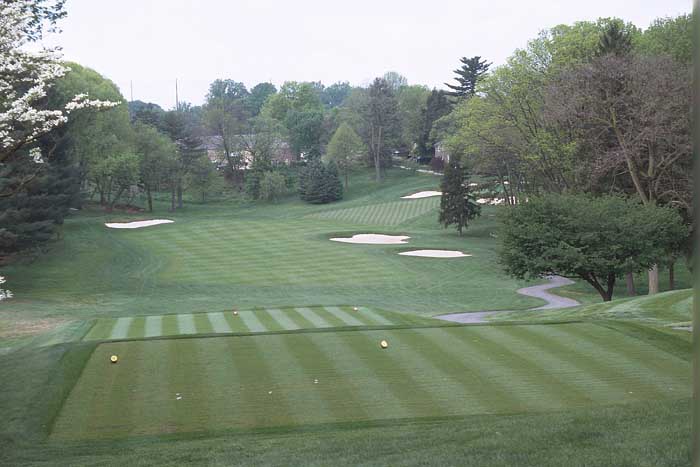
The bunkers and trees frame this beautiful tee shot. The two evergreens beyond the right side fairway bunkers should be removed immediately. They hide the green and serve little purpose except to make any approach shot from the right hand side most difficult.
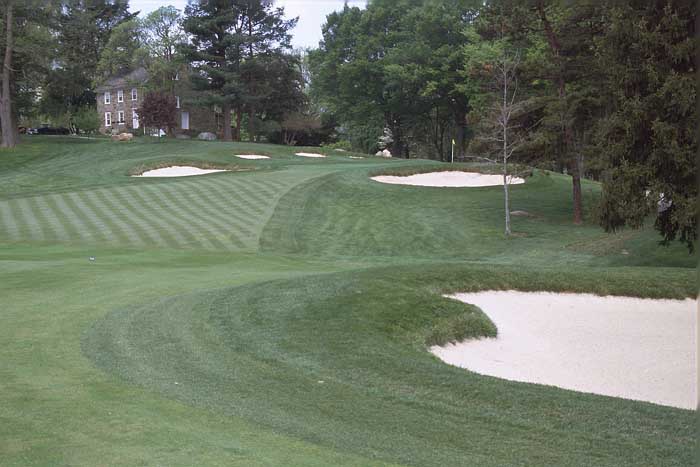
From 130 yards out the five greenside bunkers can easily be seen and weigh on the mind of the player as he attempts a delicate approach to a small green. A house dating from the late 17th century can be seen beyond the green.
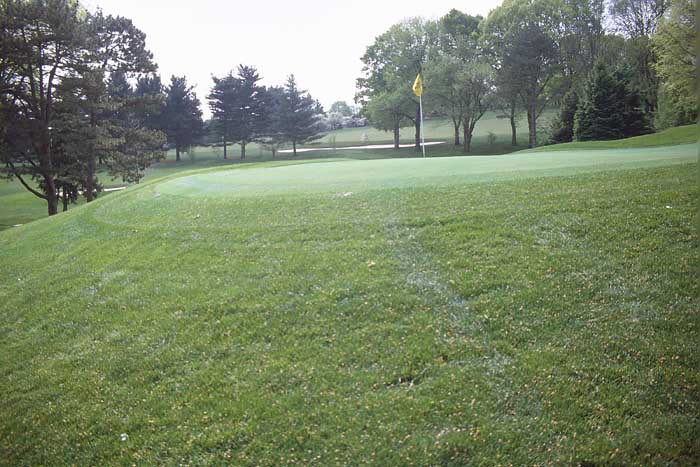
This shows the dangerous slope beyond the 12th green. The large collection bunker on the 9th fairway can be seen in the distance.
Hole 13: 434 yards, par 4
The drive on the 13th hole is fairly wide open. Best to avoid even the right edge of the fairway let alone the right rough, as there will be no clear shot to the green. A tee shot that lands on the right side will kick unfavorably to the right. The target is a small gap in the upper tree line on the left. Approximately 270 yards from the tee the fairway drops into a valley and an awaiting creek at the bottom of the slope. Long hitters should take no more than 3 wood from the back tee. There is a landing area located in the valley beyond the creek for those that cannot reach the green in two. The green is located up a steep slope from the lower fairway and is severely sloped back to front.
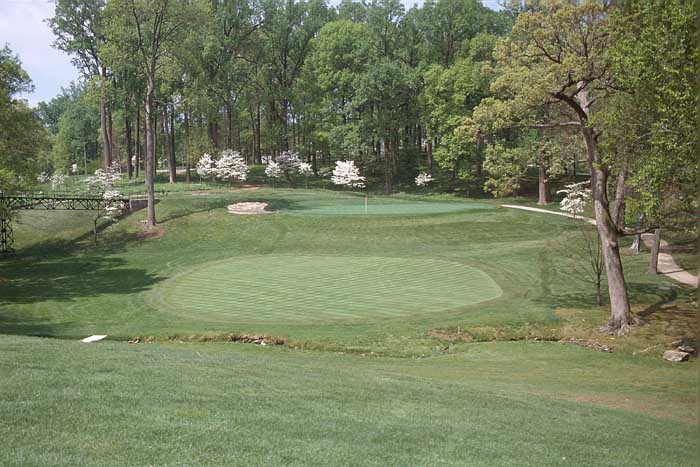
You must not leave yourself above the hole. Missing the green usually costs a one-stroke penalty.
Hole 14: 203 yards, par 3
This is one of the toughest par 3s on the course. Although a bit shorter than the 10th hole, the hazards are staring you in the face. The green is actually 10 feet above the tee box and adds to the playing yardage. A shot missed on the right faces either a difficult bunker shot in either of the two deep and steeply faced bunkers. Miss the bunkers on the right and the ball caroms far away into a valley. The green is large and difficult to putt considering the slope and internal contours. The best miss is short and left. A faded long iron off the left bunker is the shot that is demanded here.
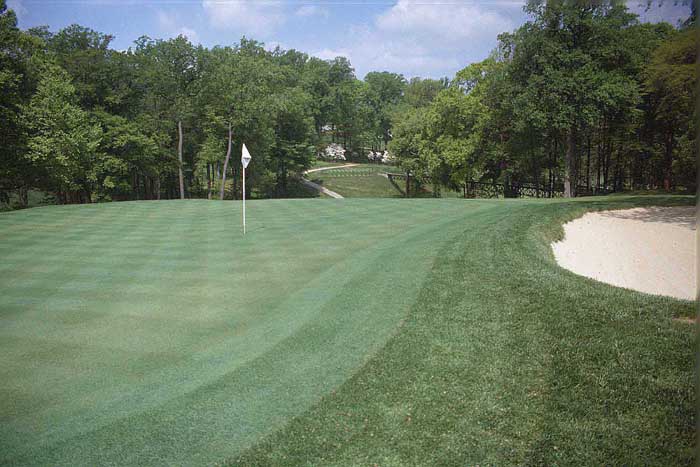
Looking back to the tee from the rear of the green. This same valley is that crossed in the opposite direction to the 13th hole.
Hole 15: 379 yards, par 4
This is a magnificent dogleg left and uphill par 4 that gave the women a great deal of trouble in the 1976 Open. A draw with a 3 wood or driver from the elevated tee is required through a narrow chute of trees that predated the course. If the shot is hit straight, no more than a three iron is required leaving a mid to long iron into the elevated and well guarded two tiered green. Balls that hit short or spin back too much will roll down the hill leaving a testy approach shot. There is a large boulder under the green that necessitated it being built with two tiers. A putt from the upper tier to the lower must nearly come to a stop if it is to stay on the green.
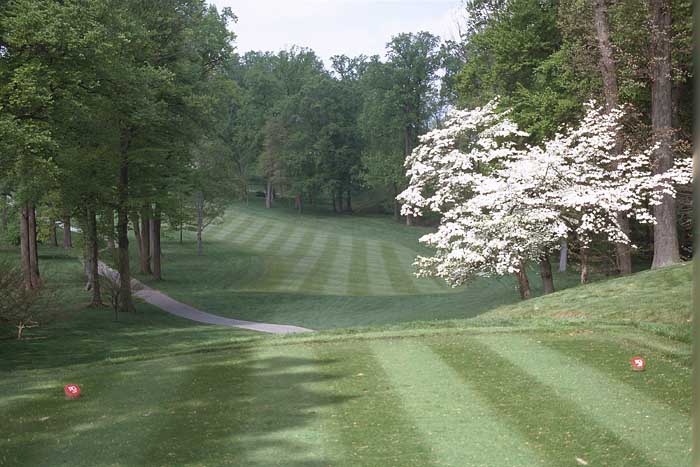
This shot is from the forward tee. A shot from the championship tee is through a much longer chute of trees.
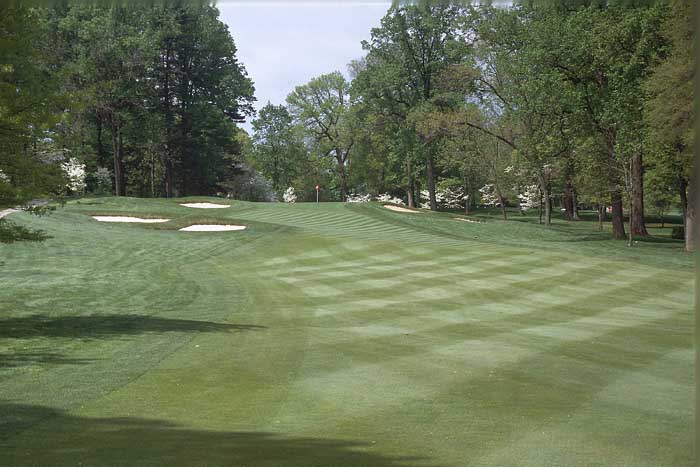
The dramatic change in elevation is not in evidence in this picture.
Hole 16: 153 yards, par 3
The green is relatively flat and will hold most tee shots. If the pin is on the right side, a deep bunker comes into play and the all-carry shot is usually a bit longer than one thinks. The hole is beautiful to look at and one of the easier holes relative to par. A new back tee on a natural rise behind the championship tee will add about 25 yards to this hole so that it plays with a different club than the 3rd hole. The 3rd hole, though longer, plays downhill and therefore with the same club as the 16th.
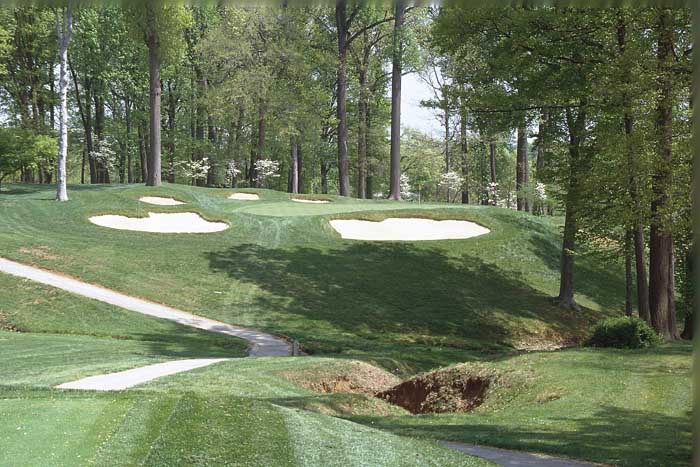
Amongst the bunkers and the trees is a green that welcomes accuracy with the short irons.
Hole 17: 475 yards, par 5
The dogleg left 17th is generally a sure par hole with an excellent chance at birdie. Although the sharp dogleg and very narrow landing area makes it difficult to reach the green in two. An accurate draw with the driver can set up a chance to go for it. A long approach shot often skips through the green leaving the player with a difficult downhill chip. Two large traps at the front of the green leave a small opening into the green for run up shots. Lofted shots that hit into the crown at the front of the green have little chance of any forward roll.
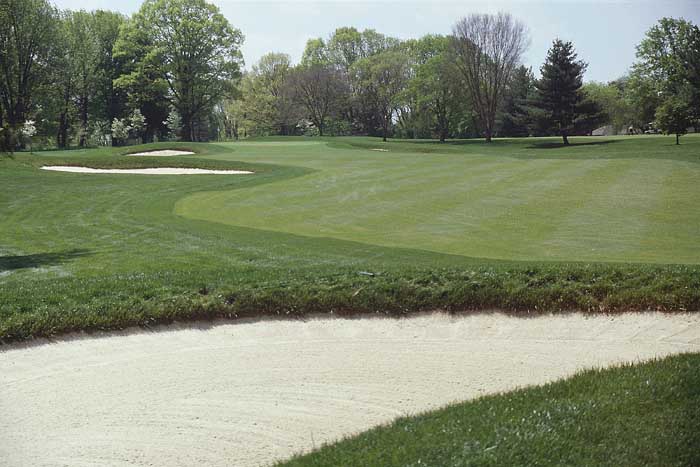
A difficult green that slopes back to front awaits.
Hole 18: 474 yards, par 4
This dogleg right hole is a par 4 from the championship tee. From the members’ tee (same tee box) it is a par 5. The downhill tee shot is to a fairway with natural rolls and a slope that goes from right to left. The best line is just inside the complex of bunkers on the right. This is a reverse dogleg. It is better to be along the outside of the dogleg for an approach to the green in two. Often a well-hit drive will get a lot of forward roll if placed just inside the bunkers and naturally move to the left. The approach to the green is steeply uphill to a large green that slopes severely from back to front.
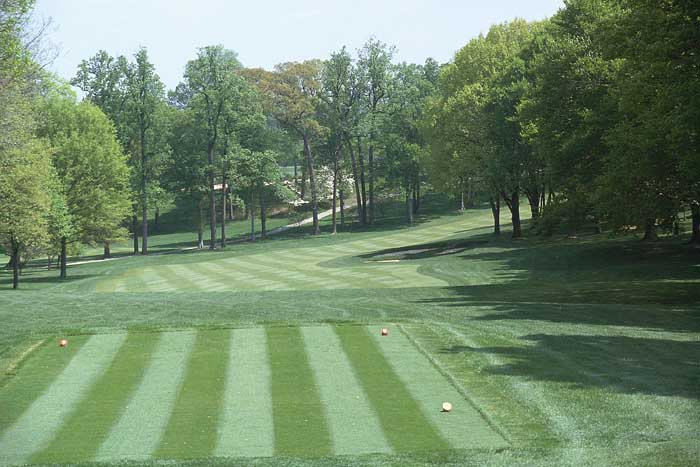
The elevated tee shot to the naturally rolling fairway that slopes right to left. Aim inside the bunkers for maximum roll and the ideal shot that ends up in the left fairway.

The large green sits at the top of the rise between two bunkers. Again a crowned front will slow any lofted shots into the green. There is plenty of room to run the ball up to the pin.
Rolling Green Golf Club is one of the great courses in a region known for its great golf. The balance and variety of holes are evident as is the natural use of the topography. This is a course that is a joy to play everyday.
The End







